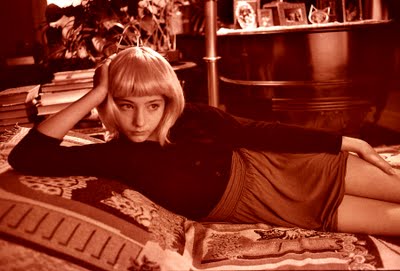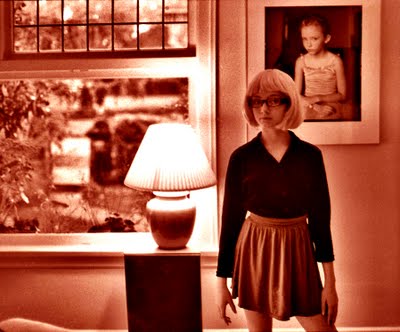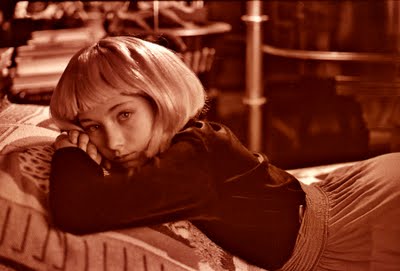High-Strung - Shadow/Highlight
Sunday, November 08, 2009

For the last couple of years I have been trying to nail down the difference in appearance between digitally taken photographs and those exposed on film. I use the expression digitally taken as, particularly in my case, when my photographs are reproduced here, in magazines, newspapers and brochures those film images have to be digitized. I use an Epson V-700 scanner that came my way via the generosity of Georgia Straight editor, Charlie Smith. I scan my b+w negatives (old colour negatives), transparencies (35mm ones taken with my Nikons and 6x7 cm taken with my Mamiya RB-67). The scanning process brings with it an inherent extra contrast which I must then reduce by using Photoshop CS. This means that no matter how much of a purist I say I am (and I don’t) there is no such thing as a Photoshop-free image in this blog.

My Photoshop CS has an image adjustment feature called Shadow/Highlight. With it I can not only bring back the shadow detail lost by my scanner but also reveal a lot of that shadow detail that previously (I must admit) was not achievable even with very good photographic paper in the darkroom. To clarify this, what I want to say is that Photoshop is not inventing shadow detail that is not there, it is simply exploiting (a drawing out) the ability of good professional film (in my case Kodak Ektachrome-G) to capture shadow detail. Until the advent of digital imaging and printing and good printing presses this detail, which was always there, was lost to the limitations of that pre-digital age.
This means that my scanner in conjunction with Photoshop CS and Corel Paint Shop Pro-X (a little secret of mine) become useful tools for the conversion of my film images into digital ones. But I still think that my images look different from the ones to be found in the social networks like Facebook and Flickr. That difference I have come to understand is the slow demise of additional lighting (soft boxes and grid lights attached to studio lighting systems).

There is another difference and for that I must use the pictures I took of Rebecca yesterday afternoon in our living room. I used Kodak Tri-X and a Nikon FM-2 with two lenses. One was a 50mm F-1.4 and the other a 35mm F-2. My exposures were at the limits of hand-hold-ability, 1/30 at f-2 or 1.4. I did not want to sacrifice the small camera freedom by resorting to a tripod. I scanned the negatives as b+w negatives but scanners still include the red/cyan, blue/yellow and magenta/green. This means that I can tint the pictures to my heart’s content. These are the results of an extreme shift to red plus a tad of yellow.
By the very fact that I am using b+w film I am narrowing down my choices. The 400 ISO speed rating of my film further narrows down my choices.
The digital shooter is prone to shoot in colour (to increase options at the time of making decisions in the post-taking- the-picture which is called digital work flow. The digital shooter will use a mode called RAW in which the shooter can put as many eggs into the digital basket. I believe that it is here where the film shooter and the digital shooter diverge with a resulting difference in the appearance of the pictures (even if the digital photographer will swear up and down that it makes no difference and the digital image can be made to look exactly like the one with film).
I think that the difference occurs simply because the moment I use b+w film of a certain speed I reduce my options. By reducing my options I can spend time taking pictures not worried by the subsequent limitations. These subsequent limitations are the very reason for the look, at least in my case, of my pictures.

I planned yesterday’s shoot with Rebecca a week before. I called up Hilary and asked her to tell Rebecca to bring clothing she had been given as a gift. This was adult clothing owned a woman who is almost Rebecca’s size. I told Hilary to tell Rebecca that I was going to try to make her look 20.
Rebecca did not pay attention to my requests and only brought her blonde Halloween wig and a purple top and black sweater. We did not start in a pleasant manner and the session (very short as I only took 16 pictures) quickly deteriorated in a mutual shouting match. “I have a headache. I want a break. I want a rest. I don’t want to pose anymore,” she told me in her high-strung (could it be she might just one day be one of those high-strung models that make more in one hour than what I make in one month?) rapid fire voice. We stopped at 14 exposures and I felt abandoned and frustrated. But I also knew that I had some good pictures in those 14. Could it be that Rebecca’s imposition of a limitation on my shooting further explains why my pictures don’t look like so many of those in social networking sites?

For me these small camera sessions have brought an excitement of what it was like to take pictures when I was young before I became an all-knowing cynic. I will just have to be more careful as I collaborate in this re-exploration of an untethered photography. The way must lie through a little girl who in growing up knows she is in control. And she is.






